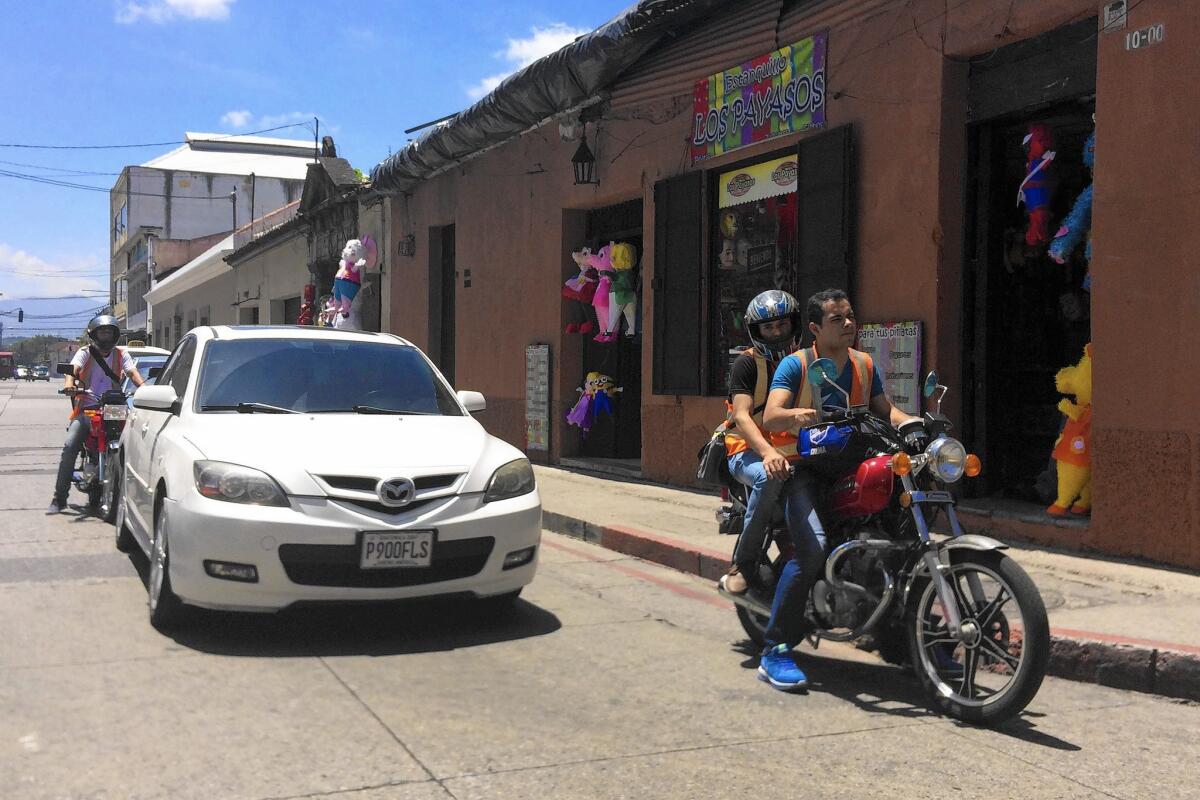Great Read: In Guatemala City, it’s the case of the missing zone

A motorcyclist speeds by shops in Guatemala City’s Zone 1, the historic center. The municipality is divided into zones that spiral out from Zone 1.
- Share via
GUATEMALA CITY — Joel Castillo furrowed his bushy eyebrows for a moment and considered the question. Then he answered confidently: “Twenty-five.”
Yes, he said, Guatemala City has 25 zones. But out of the corner of his eye, the 65-year-old uniform maker could see his co-worker Eduardo Juarez shaking his head.
“Zone 20 doesn’t exist, remember?” Juarez said.
Castillo acknowledged that he had heard that before, but he wasn’t sure why.
“Because the city planners didn’t like 20,” Juarez explained. “Poor little 20.”
A few blocks away — past the stationery shop that sells piñatas and the sign for a cellphone brand proclaiming, “Zone 10 is with Claro” — Carlos Carías held his left hand in a fist and let his fingers pop up one at a time as he counted.
“Uno, dos, tres, cuatro, cinco, seis, siete,” the 26-year-old transit policeman said, pausing.
He had to think for a moment about whether Zone 8 existed, but decided it did. Zones 20 and 22 definitely didn’t exist, though.
“Who knows why they jumped over 20 and 22,” he said, laughing.
Posed with another question — “Who are they?” — he shrugged. “The municipality,” he said, his voice rising an octave at the last syllable, enough to let you know he was really asking the question, not answering it.
SIGN UP for the free Great Reads newsletter >>
Designed as a way to give shape to a swelling metropolis, officials approved the zonification of Guatemala City — often Guate (pronounced “wah-te”) to locals — in 1952, according to the municipality’s website. Two decades later, as the city grew, leaders voted on a resolution laying out the boundaries of zones 1 through 25. No explanation was forthcoming on why three zones, including 20, were missing.
In a sprawling city such as Guate, zones are a quick way to give people a rough estimate of the spot you’re talking about. “¿Zona?” taxi drivers often ask as you hop in. The zones start near the city’s center, with Zone 1, the oldest part of the capital, home to the national palace and the central market. Then they spiral out counterclockwise.
It’s kind of a mirror image of Paris’ 20 arrondissements, which spiral out clockwise. (None of them, however, is missing.)
“Como un caracol,” many Guatemalans say. “Like a snail.”
On top of the numerical zones, the city’s Zone 10 is also called Zona Viva — the “lively zone” jammed with hotels and bars and nightclubs — and the poorest and most dangerous spots get branded una zona roja (a red zone).
How many zones exist depends on whom you ask. WikiTravel, an online travel guide, says 21, and Wikipedia puts the number at 22, saying they go up to 25, but that zones 20, 22 and 23 are missing. Nuestro Diario, a newspaper in Guatemala City, offers a post saying that there are 25 zones but that a few them technically belong to other municipalities.
The municipality’s website skips the same three as Wikipedia and links to each zone’s Facebook page.
People use the pages to post pictures of a tan chow chow named Sony who went missing from Zone 19 or to tell their leaders in Zone 5 about annoying potholes. There’s a food truck event in Zone 1 — the bustling center with a reputation for both its pickpockets and its gentrifying pockets — and there’s serious flooding on 9th Avenue in Zone 7, one of the city’s most dangerous.
In the zona whose name often lands in headlines like “Women’s bodies found in a ravine in Zone 18,” the Facebook page carries no mention of violence. Instead, there are pictures of the new skate park in the zone’s Paraíso II neighborhood — second paradise, it’s called. In rectangle-shaped Zone 19, sometimes called “the island” because it floats separate from the rest of the city, someone posts about traffic congestion.
The most infamous, though, is the missing Zone 20.
A misconception caught on several years ago, said Ángel Higüeros, chief of cartography in the municipality’s office of land registry, that the city cemetery was located in Zone 20. In a bit of local gallows humor, when someone dies in Guatemala City, some people say, “Se fue para la zona 20” — “He’s gone to Zona 20.”
For Juan Pensamiento, a 38-year-old artist, writer and legal advisor, figuring out the story behind Zone 20 became a near obsession. He remembers the day in first grade when his teacher taught the class about the city’s zones. She counted all the way to 19 and then bounced to 21. Pensamiento and his friends looked at one another, puzzled, and asked her why there wasn’t a 20.
“I have no idea,” she said. “There just isn’t.”
Her ignore-it-and-move-on answer sparked a gnawing curiosity in Pensamiento. He asked his parents. They didn’t know. Neither did his grandparents. Then, one day, he felt a rush of excitement upon meeting an urban architect — this guy has to know, he thought. He didn’t.
He questioned people from time to time over three decades, and the answer was often the same: “¿Saber?” (Guatemalans use the verb meaning “to know” as a way to say “who knows?”)
Pensamiento lives in Zone 2, a lower- to middle-class residential area that he said is turning into a “zona hipster.” His zone made international headlines during a tropical storm in 2010 with a sinkhole so deep you couldn’t see its bottom.
A few years ago, someone approached Pensamiento (whose last name translates to “Thought”) about publishing some of his short stories about urban life. He agreed, but struggled to think of a way to organize the hodgepodge of stories. They were all so different and to mush them together felt messy.
But then he thought about the idiosyncrasies of his city’s layout — about how the main landfill is in Zone 3, so close to the city center that even a simple rain sends a plume of garbage odor wafting through much of the city. He thought about how the combination of the snail-like design and traffic can mean it takes an hour to drive between two places that sound so close to each other — zones 10 and 11.
“This city is so crazy,” he said, sipping horchata in a restaurant in Zone 10. “Quite strange.”
He settled on the organizing method and titled his piece “PerZona,” a play on the Spanish words for zone and person.
In a city of gaping inequalities — “heaven and hell on the same soil,” as another person described it — Pensamiento used his book, at times, to point to the differences in people’s realities in the capital. The story about chichi Zone 10, for example, introduces a fictional 27-year-old woman with an expensive purple bag stuffed full of pills. The medicine is for her headaches, brought on by her stomachaches, brought on by her weight-loss pills.
Chapter 20, of course, is missing. But so are the chapters that would’ve corresponded with zones 8 and 17 — which no one disputes exist.
When asked about the omissions, he said he always answers the question the same way — with a question of his own: “Why doesn’t Zone 20 exist?”
He’d write the missing chapters, he told people, if he ever figured out the fate of Zone 20.
Then, about a month ago, he ran into someone who works for the municipality, who said he’d try to get to the bottom of the mystery.
Before long, the man came back with an answer: When urban engineer Raúl Aguilar Batres designed the spiral that gave shape to Guatemala City, the spot he picked for Zone 20 landed beyond the city limits, so it got skipped over.
Pensamiento wondered for a moment if the man was making up an answer to get him off his back, but the more he thought about it, the more it didn’t sound crazy. Higüeros, the municipality cartographer, confirmed the story, saying that like Zones 22 and 23, Zone 20 doesn’t exist because it fell outside the city’s limits. Today, he said, the area is a neighboring municipality’s Zone 8.
“I felt so much satisfaction,” Pensamiento said, laughing as he remembered the moment, after 32 years of curiosity, he got his answer.
But now, he said, it means more work.
It’s time to write the missing chapters.
Twitter: @marisagerber
Hoy: Léa esta historia en español
More to Read
Sign up for Essential California
The most important California stories and recommendations in your inbox every morning.
You may occasionally receive promotional content from the Los Angeles Times.














